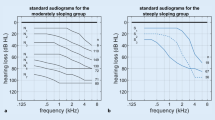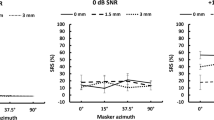Abstract
Purpose
Refinement currently offered in new sound processors may improve noise listening capability reducing constant background noise and enhancing listening in challenging signal-to-noise conditions. This study aimed to identify whether the new version of speech processor preprocessing strategy contributes to speech recognition in background noise compared to the previous generation processor.
Methods
This was a multicentric prospective cross-sectional study. Post-lingually deaf adult patients, with at least 1 year of device use and speech recognition scores above 60% on HINT sentences in quiet were invited. Speech recognition performance in quiet and in noise with sound processors with previous and recent technologies was assessed under four conditions with speech coming from the front: (a) quiet (b) fixed noise coming from the front, (c) fixed noise coming from the back, and (d) adaptive noise ratios with noise coming from the front.
Results
Forty-seven cochlear implant users were included. No significant difference was found in quiet condition. Performance with the new processor was statistically better than the previous sound processor in all three noisy conditions (p < 0.05). With fixed noise coming from the back condition, speech recognition was 62.9% with the previous technology and 73.5% on the new one (p < 0.05). The mean speech recognition in noise was also statistically higher, with 5.8 dB and 7.1 dB for the newer and older technologies (p < 0.05), respectively.
Conclusion
New technology has shown to provide benefits regarding speech recognition in noise. In addition, the new background noise reduction technology, has shown to be effective and improves speech recognition in situations of more intense noise coming from behind.



Similar content being viewed by others
Code availability
Not applicable.
References
Clark G (2003) Cochlear implants: fundamentals and applications. Springer-Verlag, New York
Frederigue NB, Bevilacqua MC (2003) Otimização da percepção da fala em deficientes auditivos usuários do sistema de implante coclear multicanal. Rev Bras Oto 69(2):227–233
Dawson PW, Mauger SJ, Hersbach AA (2011) Clinical evaluation of signal-to-noise ratio based noise reduction in nucleus cochlear-implant recipients. Ear Hear 32:382–390
Mauger SJ, Warren CD, Knight MR, Goorevich M, Nel E (2014) Clinical evaluation of the Nucleus 6 cochlear implant system: performance improvements with smart sound iQ. Int J Audiol 53(8):564–576
Warren CD, Nel E, Boyd PJ (2019) Controlled comparative clinical trial of hearing benefit outcomes for users of the Cochlear™ Nucleus(®) 7 sound processor with mobile connectivity. Cochlear Implants Int 20(3):116–126
Hey M, Hocke T, Böhnke B, Mauger SJ (2019) ForwardFocus with cochlear implant recipients in spatially separated and fluctuating competing signals - introduction of a reference metric. Int J Audiol 58(12):869–878
de Miranda-Gonsalez EC, de Almeida K (2017) Incapacidade auditiva medida por meio do questionário Speech, Spatial and Qualities of Hearing Scale (SSQ): estudo piloto da versão reduzida em Português Brasileiro. Audiol Commun Res 22:e1709
Bevilacqua MC, Banhara MR, Costa EA, Vignoly AB, Alvarenga KF (2008) The brazilian portuguese hearing in noise test (HINT). Int J Audiol 47(6):364–365
De Ceulaer G, Swinnen F, Pascoal D, Philips B, Killian M, James C, Govaerts PJ, Dhooge I (2015) Conversion of adult Nucleus® 5 cochlear implant users to the Nucleus® 6 system. Cochlear Implants Int 16(4):222–232
Nascimento LT, Bevilacqua MC (2005) Evaluation of speech perception in noise in cochlear implanted adults. Braz J Otorhinolaryngol 71(4):432–438
Plasmans A, Rushbrooke E, Moran M, Spence C, Theuwis L, Zarowski A, Offeciers E, Atkinson B, McGovern J, Dornan D, Leigh J, Kaicer A, Hollow R, Martelli L, Looi V, Nel E, Del Dot J, Cowan R, Mauger SJ (2016) A multicentre clinical evaluation of paediatric cochlear implant users upgrading to the Nucleus® 6 system. Int J Pediatr Otorhinolaryngol 83:193–199
Magalhães AT, Goffi-Gomez MV, Hoshino AC, Tsuji RK, Bento RF, Brito R (2013) Converted and upgraded maps programmed in the newer speech processor for the first generation of multichannel cochlear implant. Otol Neurotol 34(7):1193–1200
Mosnier I, Mathias N, Flament J, Amar D, Liagre-Callies A, Borel S, Ambert-Dahan E, Sterkers O, Bernardeschi D (2017) Benefit of the UltraZoom beamforming technology in noise in cochlear implant users. Eur Arch Otorhinolaryngol 274(9):3335–3342
Acknowledgements
The authors would like to thank the CI groups involved in the study, especially Prof. Dr. Ricardo Bento, Prof. Dr. Mariana Leal, Prof. Dr. Rogerio Hamerschmidt, Dr. Arthur Castilho, Prof. Dr. Shiro Tomita, Prof. Dr. Fayez Bahmad for their clinical and scientific support for this study.
Funding
Authors have no financial disclosure to declare.
Author information
Authors and Affiliations
Contributions
MVSGG and BC conceived the research idea and design. MVSGG and BC performed interpretation and analysis. All authors participated in data collection, preparing and reviewing the manuscript content.
Corresponding author
Ethics declarations
Conflict of interest
All authors have no conflict of interest to declare related to the scope of this manuscript, except BC who is a Research Manager for Cochlear Latin America.
Additional information
Publisher's Note
Springer Nature remains neutral with regard to jurisdictional claims in published maps and institutional affiliations.
Rights and permissions
About this article
Cite this article
Goffi-Gomez, M.S., Muniz, L., Wiemes, G. et al. Contribution of noise reduction pre-processing and microphone directionality strategies in the speech recognition in noise in adult cochlear implant users. Eur Arch Otorhinolaryngol 278, 2823–2828 (2021). https://doi.org/10.1007/s00405-020-06372-2
Received:
Accepted:
Published:
Issue Date:
DOI: https://doi.org/10.1007/s00405-020-06372-2




